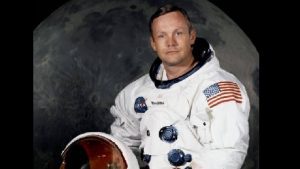
A world renowned hero, despite his modesty and love of privacy — President Obama recently called him “among the greatest of American heroes — not just of his time, but all time — Armstrong is known for having said the words, upon his landing, “That’s one small leap for man, one giant leap for mankind.”
Armstrong’s interest in aviation began young, after he enjoyed his first airplane ride at age 6 and then began building model airplanes and even conducting experiments in a homemade wind tunnel. He was licensed to fly at 16 before he was licensed to drive.
Armstrong flew in 78 combat missions in Korea for the U.S. Navy in 1949, after which he went on to graduate from Purdue, and then gain his master’s degree in aerospace engineering from the University of Southern California. In 1962 he was accepted into NASA’s second astronaut class, and in 1966 commanded the Gemini 8 mission.
The 1969 moon landing gained the largest audience any world event had every had, with one fifth the population — 600 million people — tuning in. The earth was no longer the limit, nor was the sky even the limit, but outer space had become the final frontier.
Armstrong’s service is planned for Friday. It will be private, and Armstrong’s friend U.S. Sen. Rob Portman will eulogize.







































